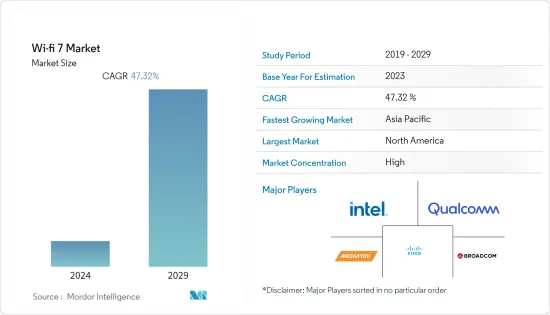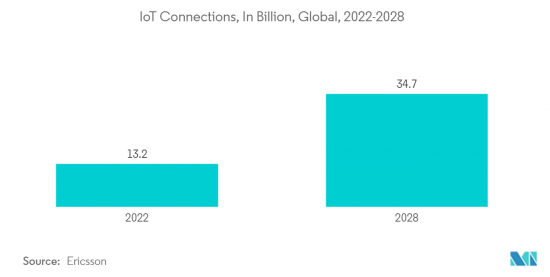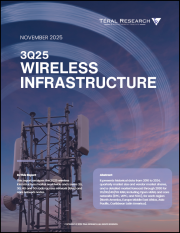
|
시장보고서
상품코드
1408569
Wi-Fi 7 : 시장 점유율 분석, 산업 동향 및 통계, 성장 예측(2024-2029년)Wi-fi 7 - Market Share Analysis, Industry Trends & Statistics, Growth Forecasts 2024 - 2029 |
||||||
Wi-Fi 7 시장 규모는 올해 8억 7,521만 달러로 추정되며, 향후 5년간 60억 7,323만 달러에 이를 것으로 예측되며, 예측 기간 중 CAGR은 47.32&로 추이하며 성장할 것으로 예상됩니다.

주요 하이라이트
- Wi-Fi 7은 IEEE 표준 802.11be로 알려져 있습니다. 2.4GHz, 5GHz, 6GHz 등 다양한 무선 주파수에서 작동합니다. 최대 40,000Mbit/s의 속도로 링크를 제공합니다. 16개의 공간 스트림과 다중 입력 다중 출력(MIMO) 기술을 통해 비디오 스트리밍의 품질과 해상도가 향상됩니다. Wi-Fi 7의 기능인 하이브리드 자동 반복 요청(HARQ)은 다중 링크 적응을 용이하게 합니다.
- 곧 출시될 IEEE 802.11 표준의 개정판인 IEEE 802.11be는 매우 높은 처리량(EHT)입니다. 802.11ax와 더불어 2.4, 5, 6GHz 주파수 대역에서 보행자 및 정지 속도로 작동하는 실내 및 실외 WLAN을 강조할 것입니다. 속도는 40Gbps로 썬더볼트와 비슷할 것으로 예상됩니다.
- 비디오 배포에 필요한 처리량은 4K/8K 비디오의 도입과 함께 수십Gbps로 계속 증가할 것입니다. 온라인 게임, 증강 현실(AR), 가상 현실(VR) 및 기타 새로운 고처리량, 저지연 비디오 애플리케이션도 폭발적으로 증가하고 있습니다. 무선 로컬 영역 네트워크(WLAN)를 통해 이러한 애플리케이션을 지원하는 것은 엄격한 요구 사항으로 인해 최신 WLAN 표준인 IEEE 802.11ax의 기능을 훨씬 뛰어넘는 것입니다.
- IEEE 802.11은 이러한 증가하는 수요를 충족하기 위해 새로운 개정 표준인 IEEE 802.11be - 무선 충실도(Wi-Fi) 7로 알려진 매우 높은 처리량(EHT)을 발표할 예정입니다. 전자 상거래, 웹 브라우징, 모바일 학습 및 기타 온라인 관련 활동에 참여하는 고객이 증가함에 따라 더 빠른 인터넷 액세스에 대한 수요가 증가하고 있습니다. 그 결과 노트북, PC, 태블릿에서 자주 사용되는 무선 라우터는 이제 우리 생활에 필수적인 존재가 되었습니다. Wi-Fi 라우터는 신뢰할 수 있는 인터넷 연결에 대한 소비자들의 요구가 증가하고 여러 국가에서 Wi-Fi 연결을 향출시키는 데 가장 큰 역할을 합니다.
- 또한 의료, 교육, 비즈니스, 금융 서비스 및 기타 애플리케이션에서 커넥티드 디바이스의 사용 증가는 전 세계 Wi-Fi 7 시장의 주요 동인 중 하나입니다. 또한, 중소기업이 기기 가져오기 정책을 채택하는 것도 시장 성장에 긍정적인 영향을 미칩니다. 또한 예상 기간 동안 스마트 시티 프로젝트에 대한 정부 이니셔티브가 급증하면서 시장 확장을위한 수익성있는 기회가 창출 될 것으로 예상됩니다.
- COVID-19의 확산을 막기 위해 이동 제한 조치가 시행되면서 경제협력개발기구(OECD) 국가의 13억 명으로 추산되는 시민 중 점점 더 많은 수가 재택근무와 재택학습을 하고 있습니다. G7이나 G20과 같은 포럼에서 중요한 국제 정책 조율이 온라인으로 이루어졌습니다. 전체 인터넷 가치 사슬에서 고정 및 모바일 광대역 사업자, 콘텐츠 및 클라우드 제공업체, 인터넷 네트워크가 트래픽을 교환하기 위해 연결된 지점, 즉 인터넷 교환 지점(IXP)은 발병 전보다 인터넷 트래픽이 60%까지 증가했습니다. 이러한 요인들은 팬데믹 이후 Wi-Fi 7 수요에 긍정적인 영향을 미쳤습니다.
Wi-fi 7 시장 동향
신흥 지역의 야외 Wi-Fi 도입에 중점을 둔 진행중인 스마트시티 프로젝트
- 스마트폰이 소비자 및 기업 환경 모두에서 다양한 애플리케이션에 걸쳐 많은 양의 데이터를 사용함에 따라 유연성을 갖춘 높은 대역폭에 대한 요구가 증가하고 있습니다. 기술이 발전함에 따라 시장 공급업체들은 더 빠른 데이터 속도, 더 낮은 지연 시간, 더 나은 네트워크 용량에 대한 요구가 증가하면서 Wi-Fi 7과 같은 고급 기술에서 기회를 창출하고 있습니다.
- 2022년 국제전기통신연합(ITU)은 전 세계 인구의 66%에 해당하는 53억 명이 인터넷을 사용할 것으로 예상했습니다. 이는 2019년에 비해 24% 성장한 수치이며, 같은 기간 동안 11억 명이 인터넷에 가입할 것으로 예상됩니다. 이러한 인터넷 보급률의 증가는 국내외 Wi-Fi 7 공급업체가 새로운 제품을 출시하고 대역폭을 늘려 주요 시장 점유율을 확보할 수 있는 기회를 크게 창출할 것입니다.
- 스마트 시티는 무료 공용 인터넷 액세스를 제공하는 것 외에도 트래픽 전자 라우팅, 대기 오염 모니터링, 물과 연결 절약, 지역 주민의 안전을 보장하면서 지역 주민과 협력하는 등 다양한 목적으로 Wi-Fi를 사용합니다. 예를 들어, Wi-Fi 연결은 지역 주민과 방문객 모두에게 더욱 중요한 편의시설이 되고 있습니다. 특히 해외를 여행하면서 과도한 로밍 요금을 피하고 싶고 내비게이션과 관광을 지속적으로 이용하고자 하는 관광객에게는 필수적일 수 있습니다. 스마트 시티의 부상은 시장에 긍정적인 영향을 미칠 것입니다.
- 미국 지역의 여러 정부도 스마트 시티의 도입과 이에 따른 Wi-Fi 7의 도입을 장려하고 있습니다. 예를 들어, 라스베이거스는 2025년까지 도시 전체를 연결하는 방법을 찾기 위해 5억 달러를 배정하여 세 가지 시범 프로젝트를 테스트하고 있습니다. 정부가 진행하는 스마트 시티 프로젝트의 수가 증가하는 것도 Wi-Fi 라우터 시장 수요에 영향을 미치는 또 다른 요인입니다.
- 또한, 각국 정부가 스마트 시티 프로젝트의 확장을 지원하는 것도 시장의 주요 트렌드입니다. 인도 주택 도시부의 도움으로 인도는 2023년까지 인구 5,00,000명을 수용할 수 있는 4,000개의 도시를 개발하는 것을 목표로 하고 있습니다. 따라서 그래프에서 볼 수 있듯이 스마트 시티와 함께 성장하는 IoT는 예측 기간 동안 Wi-Fi 7 기술에 대한 상당한 수요를 창출 할 것으로 분석됩니다.

북미가 시장에서 최대 점유율을 달성
- 북미는 미국과 캐나다의 두 가지 신흥 경제 국가로 구성되어 있습니다. 이 지역에서는 스마트 공장의 도입이 확대되고 있으며, 이것이 북미 시장의 성장을 가속하는 주요 요인이 되고 있습니다. Wi-Fi 칩셋, 산업용 PC, 게이트웨이 장치, PLC, 산업용 로봇 및 무선 센서는 모두 스마트 공장 시스템에서 널리 사용됩니다. 스마트 공장에서 무선 연결 장치와 IoT 인프라가 확대됨에 따라 Wi-Fi 7 시장은 높은 성장을 기대하고 있습니다.
- 이 지역에서는 에너지 절약 및 저 배출 솔루션 수요로 스마트 홈 도입이 증가하고 있습니다. 국가의 경제적 번영에 필수적인 요소는 에너지 효율입니다. 지구온난화의 심각화와 정부의 법규제 결과, 이 지역에서는 에너지사용과 이산화탄소 배출을 최소화하는 수요가 높아지고 있습니다. 스마트 홈 기능에는 스마트 장치가 필요하며, 이는 북미에서 Wi-Fi 7의 비즈니스 기회를 창출합니다.
- 또한 많은 세계 기업과 지역 기업들이 이 지역의 스마트 장치에 통합할 수 있는 고급 Wi-Fi 칩셋을 개발하고 있습니다. 예를 들어, 2022년 3월 미국 Broadcom은 1년 동안 5억개의 Wi-Fi 6/6E 칩 중 10억개의 Wi-Fi 6/6E 칩을 공급했습니다. 이 회사는 향후 필요에 따라 Wi-Fi 7 칩셋을 생산할 예정입니다.
- 2022년 8월 Qualcomm Technologies는 42억 달러의 추가 지출을 약속했으며 GlobalFoundries의 미국 공장에서 생산되는 반도체 칩에 소비되는 총 금액은 74억 달러에 달했습니다. 이 중 32억 달러의 계약은 5G 트랜시버, Wi-Fi, 자동차, 사물인터넷(IoT)용 칩을 대상으로 하고 있습니다. Qualcomm은 웨이퍼 공급을 확보하고 2028년 말까지 GlobalFoundries의 뉴욕 공장 생산 능력을 강화할 것이라고 발표했습니다.
- 캐나다도 Wi-Fi용으로 6GHz대를 개방하기로 결정했고 다른 많은 나라에 합류했습니다. ISED에 따르면 6GHz 대역의 주파수 변화는 캐나다 전역에 걸쳐 최대의 Wi-Fi 개선을 가져옵니다. 업계에서는 Wi-Fi 6E 기기가 최근 출시되었음에도 불구하고 대역폭이 더욱 크게 증가하는 Wi-Fi 7이 2024년까지 출시될 것으로 예상하고 있습니다. 이러한 요인은 이 지역에서 Wi-Fi 7 시장의 성장에 크게 기여하고 있습니다.
Wi-Fi 7 산업 개요
Wi-Fi 7 시장 특징은 시장 점유율을 크게 차지하는 주요 기업이 집중되어 있다는 것입니다. 이러한 주요 기업들은 예측 기간 동안 경쟁을 유지하기 위해 여러 제품을 적극적으로 투입하고 있습니다.
2023년 6월 Broadcom Inc.는 Wi-Fi 7 에코시스템을 위해 조정된 2세대 무선 연결 칩셋 솔루션의 출시와 가용성에 대한 주목할만한 발표를 했습니다. 이러한 솔루션에는 Wi-Fi 라우터, 기업용 액세스 포인트, 주거용 게이트웨이, 클라이언트 장비 등 다양한 제품이 포함됩니다. 이러한 새로운 칩의 특징은 보다 폭넓은 고객층에 대응하는 기능성 향상입니다. 게다가 이 칩은 Broadcom의 1세대 Wi-Fi 7 기반 위에 구축되어 주요 시장 외에도 다양한 시장에서 사용할 수 있습니다.
2022년 6월 Qualcomm Technologies, Inc.는 일류 Wi-Fi 및 블루투스 경험을 제공하도록 설계된 RFFE 모듈 세트를 발표했습니다. 이 확장 포트폴리오는 Bluetooth, Wi-Fi 6E 및 향후 Wi-Fi 7 표준을 지원합니다. 이러한 모듈은 스마트폰뿐만 아니라 차량 탑재, 증강현실(XR), 퍼스널 컴퓨터(PC), 웨어러블, 모바일 광대역, 사물 인터넷(IoT) 등 다양한 기기 부문을 수용하도록 설계되었습니다.
Broadcom Inc.는 2022년 4월 Wi-Fi 7 에코시스템 전용으로 설계된 종합적인 엔드 투 엔드 칩셋 솔루션을 발표했습니다. 이 종합적인 라인업은 Wi-Fi 라우터, 주거용 게이트웨이, 엔터프라이즈 액세스 포인트 및 클라이언트 장치를 다룹니다. 특히 Broadcom의 최신 Wi-Fi 7 칩셋은 320MHz 채널을 제공함으로써 Wi-Fi 채널 대역폭을 두 배로 늘릴 것으로 기대됩니다. 이 진보는 6GHz 대역의 세계 Wi-Fi 스펙트럼의 확장과 완벽하게 일치하므로 시장에 큰 도움이 됩니다.
기타 혜택 :
- 엑셀 형식 시장 예측(ME) 시트
- 3개월간의 애널리스트 서포트
목차
제1장 서론
- 조사 전제 조건 및 시장 정의
- 조사 범위
제2장 조사 방법
제3장 주요 요약
제4장 시장 인사이트
- 시장 개요
- 업계의 매력도-Porter's Five Forces 분석
- 구매자의 협상력
- 공급기업의 협상력
- 신규 참가업체의 위협
- 대체품의 위협
- 경쟁 기업간 경쟁 관계
- Wi-Fi 규격과 규제의 진화
- 시장에 영향을 미치는 거시경제 요인
제5장 시장 역학
- 시장 성장 촉진 요인
- 주요 시장에서 스마트 가전 기기 수요 증가
- 신흥 지역의 야외 Wi-Fi 도입에 초점을 맞춘 진행중인 스마트시티 프로젝트
- 시장 성장 억제 요인
- 고밀도 환경에서 운영상 과제
- 옥외 지역에서 실장에 관한 우려
제6장 시장 세분화
- 유형별
- 하드웨어
- 액세스 포인트
- 게이트웨이
- 라우터와 중계기
- 서비스별
- 하드웨어
- 용도별
- 실내
- 옥외
- 지역별
- 북미
- 유럽
- 아시아태평양
- 남미
- 중동 및 아프리카
제7장 경쟁 구도
- 기업 개요
- Intel Corporation
- Broadcom Inc.
- Cisco Systems Inc.
- Qualcomm
- MediaTek Inc.
- Huawei Technologies Co. Ltd
- TP-Link
- Rohde&Schwarz
- HFCL
- Netgear
제8장 투자 분석
제9장 시장 기회 및 향후 동향
LYJ 24.01.31
The Wi-Fi 7 market market was valued at USD 875.21 million in the current year and is expected to reach USD 6073.23 million in the next five years, registering a CAGR of 47.32% over the forecast period.
Key Highlights
- Wi-Fi 7 is known as the IEEE standard 802.11be. It works with several different radio frequencies, including 2.4GHz, 5GHz, and 6GHz. It offers links at a maximum speed of 40,000 Mbit/s. The quality and resolution of video streaming are improved by 16 spatial streams and Multiple Input Multiple Output (MIMO) technology. Hybrid Automatic Repeat Request (HARQ), a feature of Wi-Fi 7, facilitates multiple link adaptation.
- The upcoming revision of the IEEE 802.11 standard, called IEEE 802.11be, is Extremely High Throughput (EHT). On top of 802.11ax, it will emphasize WLAN indoor and outdoor operating at pedestrian and stationary speeds in the 2.4, 5, and 6 GHz frequency bands. It is anticipated that the speeds will match Thunderbolt at 40 Gbps.
- The throughput needed for video distribution will continue to rise to tens of Gbps with the introduction of 4k/8k video. Online gaming, augmented reality (AR), virtual reality (VR), and other fresh, high-throughput, and low-latency video applications are also exploding. Supporting these applications over a wireless local area network (WLAN) is much beyond the capabilities of the latest WLAN standard, IEEE 802.11ax, because of the associated strict requirements.
- The IEEE 802.11 will publish a new amendment standard, IEEE 802.11be - Extremely High Throughput (EHT), often known as Wireless-Fidelity (Wi-Fi) 7, to satisfy these growing demands. A growing number of customers are engaging in e-commerce transactions, web browsing, mobile learning, and other online-related activities, driving the demand for faster internet access. As a result, the wireless router, frequently utilized in laptops, PCs, and tablets, has become essential for human existence. Wi-Fi routers are mostly responsible for the rising need among consumers to stay linked to dependable Internet and for enhancing Wi-Fi connections in numerous nations.
- Moreover, the increasing use of connected devices in healthcare, education, business, financial services, and other applications is one of the key drivers of the worldwide Wi-Fi 7 market. Additionally, the market growth is positively impacted by small and medium businesses adopting a bring your device policy. Further, during the projected period, a surge in government initiatives for smart city projects is anticipated to create lucrative opportunities for market expansion.
- As mobility restrictions were enforced to contain the spread of the coronavirus (COVID-19), more and more of the estimated 1.3 billion citizens of Organization for Economic Cooperation and Development (OECD) countries worked and studied from home. Critical international policy coordination was conducted online in fora, such as the G7 or G20. Along the entire Internet value chain, fixed and mobile broadband operators, content and cloud providers, and points where Internet networks connected to exchange traffic, called Internet exchange points (IXPs), experienced as much as 60% more Internet traffic than before the outbreak. These factors positively affected the demand for Wi-Fi 7 post-pandemic.
Wi-fi 7 Market Trends
Ongoing Smart City Projects Focused on Deployment of Outdoor Wi-Fi in Emerging Regions
- As smartphones have a combination of volume and heavy data usage across a wide variety of applications in both consumer and enterprise settings, the need for high bandwidth with flexibility is increasing. As technology evolves, market vendors have been getting the increased need for higher data rates, lower latency, and better network capacity, thus creating opportunities in advanced technologies such as Wi-Fi 7.
- In 2022, the International Telecommunication Union (ITU) estimated that 5.3 billion people, or 66% of the world's population, utilize the Internet. This marks a 24% growth from 2019, with an expected 1.1 billion people joining the Internet throughout that time. Such a rise in internet penetration will significantly create opportunities for local and international Wi-Fi 7 vendors to introduce new products and increase the bandwidth to capture the major market share.
- In addition to providing free public Internet access, smart cities use Wi-Fi for various purposes, including e-routing traffic, monitoring air pollution, conserving water and connection, and cooperating with locals while ensuring their safety. For instance, Wi-Fi connection is becoming a more important amenity for both locals and visitors. It can be vital for tourists who may want continual access to navigation and sightseeing, especially if they are traveling abroad and wish to avoid exorbitant roaming fees. The rise in smart cities will create a positive impact on the market.
- Various governments in the American region are also promoting the adoption of smart cities and, therefore, the adoption of Wi-Fi 7. For instance, Las Vegas is testing three pilot projects, with the government allocating USD 500 million to find ways to connect the entire city by 2025. The increase in the number of smart city projects undertaken by governments is another factor influencing the demand for the Wi-Fi router market.
- Further, national governments aiding the expansion of smart city projects is also a key trend in the market. With the help of the Ministry of Housing and Urban Affairs in India, the nation aims to develop 4,000 cities to house a population of 5,00,000 each by 2023. Therefore, as indicated in the graph, the growing IoT with the smart cities is analyzed to create significant demand for the Wi-Fi 7 technology during the forecast period.

North America is Analyzed to Hold Largest Share in the Market
- The North American region consists of two developed economies, the USA and Canada. The growing adoption of smart factories in the region is the primary factor driving the market growth in North America. Wi-Fi chipsets, industrial PCs, gateway devices, PLCs, industrial robots, and wireless sensors are all broadly used in the systems of smart factories. High-growth prospects are being created for the Wi-Fi 7 market by expanding wirelessly connected devices and IoT infrastructure in smart factories.
- Smart home adoption in the region is increasing due to the demand for energy-saving and low-emission solutions. An essential component of a nation's economic prosperity is energy efficiency. As a result of escalating global warming and governmental laws, there has been an increasing demand to minimize energy use and carbon emissions in the region. Smart homes need smart devices to be functional, which is creating an opportunity for Wi-Fi 7 in North America.
- Further, many global and regional companies are developing advanced Wi-Fi Chipsets to integrate those into the smart devices in the region. For example, in March 2022, Broadcom, an American company, supplied a billion Wi-Fi 6/6E chips, out of which 500 million Wi-Fi 6/6E chips were supplied in a year. The company will produce Wi-Fi 7 chipsets in the future according to the need.
- In August 2022, Qualcomm Technologies committed to spending an additional USD 4.2 billion, bringing the total amount spent on semiconductor chips produced at a US facility of GlobalFoundries to USD 7.4 billion, out of which the USD 3.2 billion contracts with the corporation cover chips for 5G transceivers, Wi-Fi, vehicles, and the Internet of Things (IoT). Qualcomm announced that it has secured wafer supply and pledges to increase the capacity of GlobalFoundries' New York factory by the end of 2028, which will drive the Wi-Fi-Chipset market in the region.
- Canada has also decided to open up 6GHz for Wi-Fi, joining many other nations. According to ISED, the largest Wi-Fi improvement for all Canadians would be brought about by the 6 GHz spectrum modification. The industry anticipates Wi-Fi 7 to launch by 2024 with still another significant increase in bandwidth, even though Wi-Fi 6E devices have only recently launched. These factors are significantly contributing to the Wi-Fi 7 market growth in the region.
Wi-fi 7 Industry Overview
The Wi-Fi 7 market is characterized by a significant concentration of major players who collectively hold a substantial market share. These key players are actively introducing multiple products to maintain their competitive edge throughout the projected period.
In June 2023, Broadcom Inc. made a noteworthy announcement regarding the release and availability of its second-generation wireless connectivity chipset solutions tailored for the Wi-Fi 7 ecosystem. These solutions encompass a wide range of products, including Wi-Fi routers, enterprise access points, residential gateways, and client devices. What sets these new chips apart is their enhanced functionality, catering to a broader customer base. Additionally, these chips are built on the foundation of Broadcom's original generation Wi-Fi 7, enabling their use in various markets beyond the primary one.
In June 2022, Qualcomm Technologies, Inc. unveiled a series of RFFE modules designed to deliver top-notch Wi-Fi and Bluetooth experiences. This expanded portfolio caters to Bluetooth, Wi-Fi 6E, and the upcoming Wi-Fi 7 standard. These modules are thoughtfully crafted to serve a diverse range of device segments, extending beyond smartphones to include automotive, extended reality (XR), personal computers (PCs), wearables, mobile broadband, Internet of Things (IoT), and more.
In April 2022, Broadcom Inc. announced the full availability of its comprehensive end-to-end chipset solutions designed specifically for the Wi-Fi 7 ecosystem. This comprehensive lineup covers Wi-Fi routers, residential gateways, enterprise access points, and client devices. Notably, Broadcom's latest Wi-Fi 7 chipsets are expected to double the Wi-Fi channel bandwidth by offering 320 MHz channels. This advancement aligns perfectly with the expanded global Wi-Fi spectrum in the 6 GHz band, making it a valuable addition to the market.
Additional Benefits:
- The market estimate (ME) sheet in Excel format
- 3 months of analyst support
TABLE OF CONTENTS
1 INTRODUCTION
- 1.1 Study Assumptions and Market Definition
- 1.2 Scope of the Study
2 RESEARCH METHODOLOGY
3 EXECUTIVE SUMMARY
4 MARKET INSIGHTS
- 4.1 Market Overview
- 4.2 Industry Attractiveness - Porter's Five Forces Analysis
- 4.2.1 Bargaining Power of Buyers
- 4.2.2 Bargaining Power of Suppliers
- 4.2.3 Threat of New Entrants
- 4.2.4 Threat of Substitutes
- 4.2.5 Intensity of Competitive Rivalry
- 4.3 Evolution of Wi-Fi Standards and Regulations
- 4.4 Macro Economic Factors Impacting the market
5 MARKET DYNAMICS
- 5.1 Market Drivers
- 5.1.1 Rise in Demand for Smart Consumer Electronics Devices in the Major Markets
- 5.1.2 Ongoing Smart City Projects Focused on Deployment of Outdoor Wi-Fi in Emerging Regions
- 5.2 Market Restraints
- 5.2.1 Operational Challenges in Denser Environments
- 5.2.2 Concerns Related to Implementation in Outdoor Areas
6 MARKET SEGMENTATION
- 6.1 By Type
- 6.1.1 Hardware
- 6.1.1.1 Access Points
- 6.1.1.2 Gateways
- 6.1.1.3 Routers and Extenders
- 6.1.2 Services
- 6.1.1 Hardware
- 6.2 By Application
- 6.2.1 Indoor
- 6.2.2 Outdoor
- 6.3 By Region
- 6.3.1 North America
- 6.3.2 Europe
- 6.3.3 Asia-Pacific
- 6.3.4 Latin America
- 6.3.5 Middle East and Africa
7 COMPETITIVE LANDSCAPE
- 7.1 Company Profiles
- 7.1.1 Intel Corporation
- 7.1.2 Broadcom Inc.
- 7.1.3 Cisco Systems Inc.
- 7.1.4 Qualcomm
- 7.1.5 MediaTek Inc.
- 7.1.6 Huawei Technologies Co. Ltd
- 7.1.7 TP-Link
- 7.1.8 Rohde & Schwarz
- 7.1.9 HFCL
- 7.1.10 Netgear



















